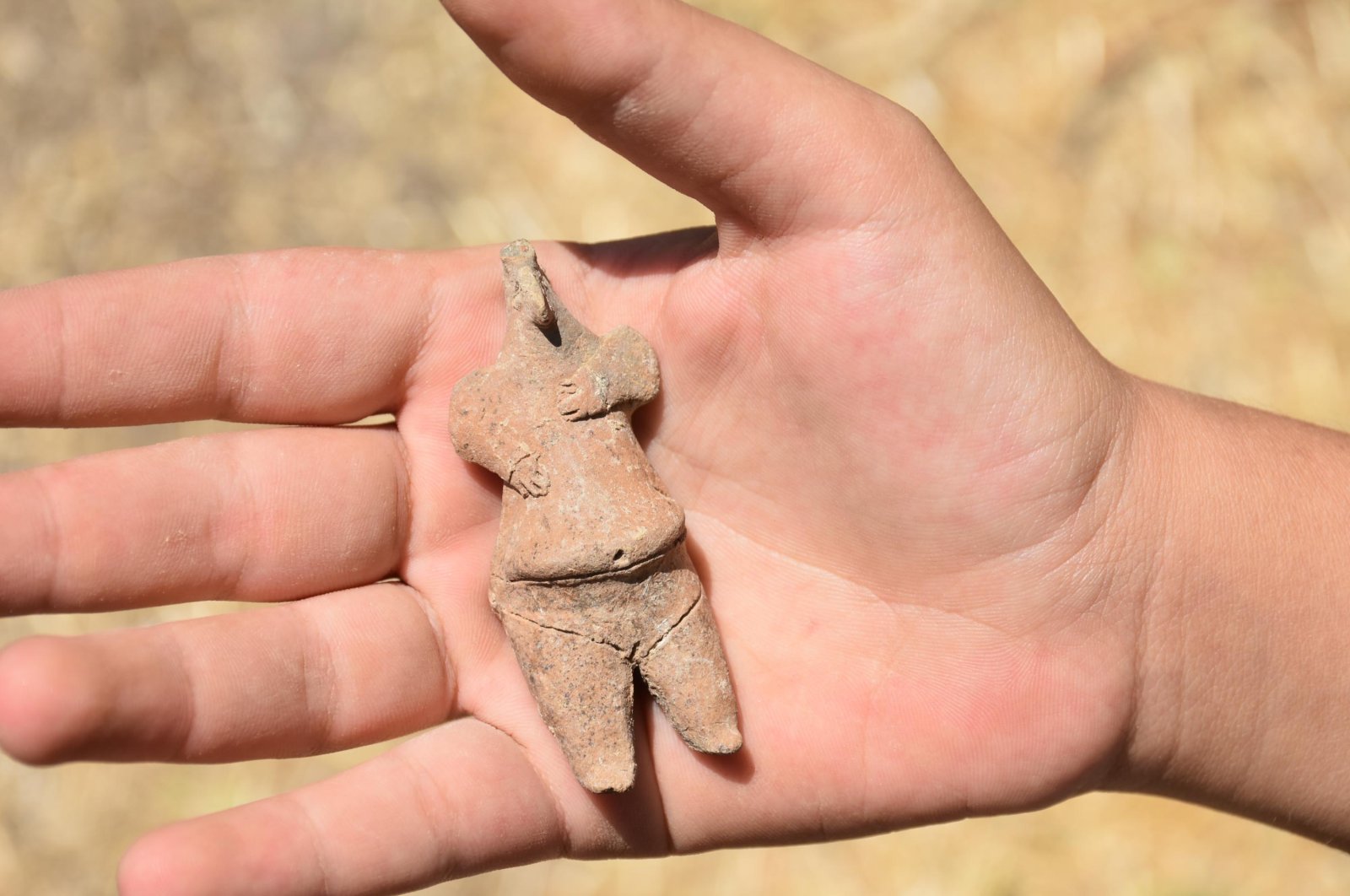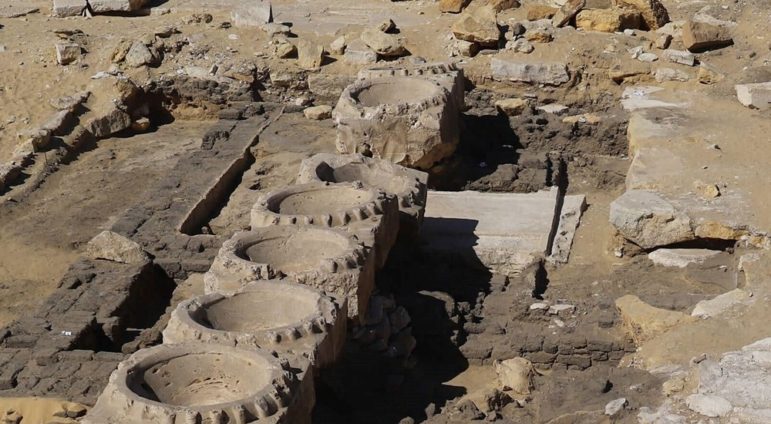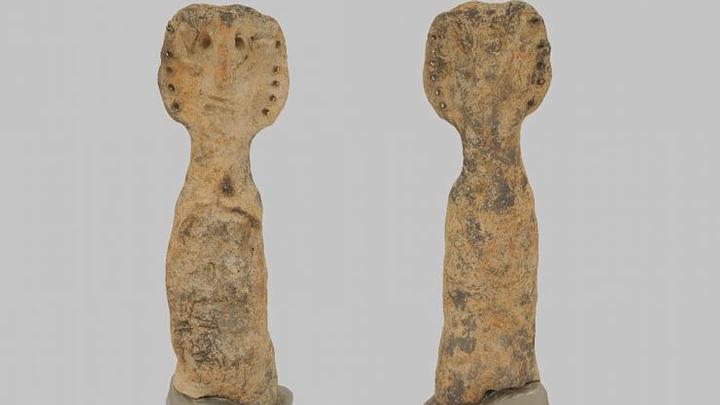
There are many articles and essays about new archaeology finds that are of interest to modern Pagans, Heathens, and polytheists out there, more than our team can write about in-depth in any given week. Therefore, since have not let them out in quite a while, The Wild Hunt must unleash the hounds in order to round them all up. Here are our favorite picks from recent months.
IZMIR, Türkiye – The Izmir Archaeology Museum in Türkiye will be displaying artifacts of the goddess Nike during a special exhibition. The artifacts will be displayed this August as part of a project called, “You Will See What You Can’t See.” The project will present rarely seen artifacts or items in museum storage for public view every month. Nike is often depicted as winged standing next to the throne of Zeus.
There are three artifacts of Nike on display. The first is a 2,000-year-old 19-inch (49 cm) marble column unearthed in 1925 C.E. in Izmir depicting Nike with laurel leaves. The second artifact is a 2,500-year-old votive clay lamp depicting Nike around the lamp’s flame. The last object is a Nike figure believed to be a burial gift.
In other news from Izmir, Professor Dr. Özlem Çevik from the Department of Protohistory and Pre-Asian Archeology at Trakya University’s Faculty of Letters announced the discovery of a 7,800-year-old small clay statue at the Ulucak Mound excavation in the Kemalpaşa district.
Little is currently known about the female figurine. They were thought to depict deities but archeologists have found them outside of sacred places leading many to suspect they commemorate an important event such as a birth or a harvest. They may also have been used in witchcraft rituals, for abundance or fertility.

The 7,800-year-old female figurine found in Ulucak Mound, Izmir, Türkiye, Aug. 8, 2022. (Image Credit: DHA)
The professor told the Anadolu Agency the mound had been inhabited continuously for 45 generations. “It is among the oldest settlements in Western Anatolia, and we have unearthed findings dating back 8,850 years in the mound,” Çevik said.
MANISA, Türkiye – The only existing statue of Hestia to have survived from the Hellenistic period, will be exhibited at the Manisa Archeology Museum later this year. The 10.2 ft (2.7 m) bronze statue was unearthed in 2005 in the ancient city of Aigai, the royal capital of Macedon. The city was later named Aeolus in the Roman era. It was destroyed in 17 CE and aided in reconstruction by Emperor Tiberius.
Associate Professor Yusuf Sezgin, who headed the excavation said, “Currently, work is carried out in the Sanctuary of Athena. In ancient times, cities had certain gods or goddesses. Athena is the goddess of wisdom and intelligence. Obviously, the most important goddess in Aigai was Athena. Because a temple was built at the highest point of the city, in its most magnificent place. We started work here in 2019. The area was covered with brushwood and rubble. After some work, it began to surface gradually.”

Statue of Hestia found in Türkiye [Image via Reddit]
The professor noted, “This is actually a sacred area” and there are no other similar examples of Hestia yet discovered from the Hellenistic Period.
“There is no statue of Hestia from the Hellenistic Period anywhere in the world. Restoration of these statues, including Hestia, will begin soon and will be exhibited at the Manisa Archeology Museum,” Sezgin said.
The area was continuously inhabited for 1,000 years and also contains a necropolis with some 3,500 graves in the surface. The continuing archaeological exploration and excavation of the area will determine if graves are present underground.
CAIRO – Egypt’s Ministry of Tourism and Antiquities announced that traces of a previously unknown cult temple dedicated to the Egyptian supreme god Ra had been unearthed south of Cairo by a team of Italian and Polish archeologists.
Massimiliano Nuzzolo of the Polish Academy of Sciences and Rosanna Pirelli of the University of Naples L’Orientale were the lead archeologists at the mudbrick structure site of Abu Ghurab. The builder or builders of the site is yet unknown but it is thought to have been built either by Shepseskare, who ruled from about 2438 to 2431 B.C.E., or Neferefre, who ruled from about 2431 to 2420 B.C.E.

Image credit: Egyptian Ministry of Tourism and Antiquities
The main structure measures at least 197 feet by 66 feet and consists of a portico of limestone columns. The site’s L-shaped entrance leads to a courtyard and storage area as well as a series of rooms of as-yet unknown cultic purposes. The site contains dozens of jars of beer and others substances decorated in a red pigment.
Dr. Nuzzolo explained, “The walls of this building were all plastered in black and white and often also show traces of painting in red and blue.” He added that the site was ritually demolished and a new temple was built of stone in the same location for Niuserre, who reigned from 2420 to 2389 B.C.E.
MUNICH – The Bavarian State Office for the Preservation of Monuments announced the discovery of small 7.5-inch (19 cm) figurines that may represent a prehistoric water goddess. Archaeologists discovered the ceramic figure in a prehistoric gully near a Hallstatt-period settlement that existed in the 8th and 6th centuries BCE. The settlement is on the edge of the Unkenbach lowland in what is now Mönchstockheim in the Schweinfurt district.
The figurines were found during the construction of a state roadway, the Mönchstockheim bypass, and their discovery resulted in the immediate deployment of archeologists in a rescue and preservation mission.

Image Credit: Bavarian State Office for the Preservation of Monuments
The figurines, which may have been a few inches taller originally, are made of clay. Archeologists are not clear about the gender represented by the figurines, but they have a headdress that was typically worn by women of that time. The headdress also has holes around the edge whose purpose is not clear.
Researchers say the figurines may date to the 5th millennium BCE and are from the Black Sea region.

Image Credit: Bavarian State Office for the Preservation of Monuments
The culture of the area at the time was dominated by farming but metalworking was advanced and long-distance trade with Mediterranean cultures had been occurring and was economically important.
As to the purpose of the figurines and how they got there, future research will explore those questions. Curator General Prof. Mathias Pfeil, head of the Office, speculated, “It is possible that people at that time regarded this special scenic spot as a sacred place and that the small statuette served as a ritual offering or even had magical powers.”
The Wild Hunt is not responsible for links to external content.
To join a conversation on this post:
Visit our The Wild Hunt subreddit! Point your favorite browser to https://www.reddit.com/r/The_Wild_Hunt_News/, then click “JOIN”. Make sure to click the bell, too, to be notified of new articles posted to our subreddit.

